Related Research Articles

Eric Arthur Blair, better known by his pen name George Orwell, was an English novelist, essayist, journalist, and critic. His work is characterised by lucid prose, social criticism, opposition to totalitarianism, and support of democratic socialism.

The Glasgow Subway is an underground light metro system in Glasgow, Scotland. Opened on 14 December 1896, it is the fourth-oldest underground rail transit system in Europe after the London Underground, Liverpool's Mersey Railway and the Budapest Metro. It is also one of the very few railways in the world with a track running gauge of 4 ft wide. Originally a cable railway, the subway was later electrified, but the double-track circular line was never expanded. The line was originally known as the Glasgow District Subway, and was later renamed Glasgow Subway Railway. In 1936 it was renamed the Glasgow Underground. Despite this rebranding, many Glaswegians continued to refer to the network as "the Subway". In 2003, the name "Subway" was officially readopted by its operator, the Strathclyde Partnership for Transport (SPT). A £40,000 study examining the feasibility of an expansion into the city's south side was conducted in 2005 while a further commitment from Labour in 2007 to extend to the East End was also to no avail.

The Alfa Romeo SZ or ES-30 is a high-performance limited-production sports car built between 1989 and 1991 by a partnership between Centro Stile Zagato, Centro Stile Alfa Romeo and Centro Stile Fiat. It was unveiled as the ES-30 at the 1989 Geneva Motor Show as a prototype by Zagato, although the car was mainly built by them - not designed mechanically.

Shooting brake is a car body style which originated in the 1890s as a horse-drawn wagon used to transport shooting parties with their equipment and game.
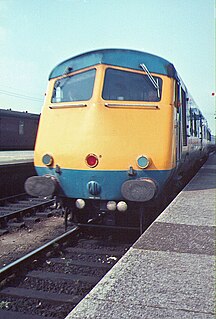
The Blue Pullmans were luxury trains used from 1960 to 1973 by British Rail. They were the first Pullman diesel-electric multiple units, incorporating several novel features.
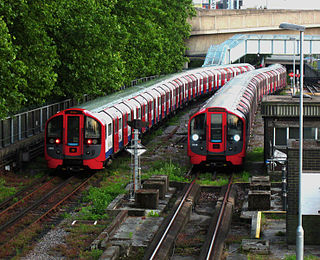
London Underground rolling stock includes the electric multiple units that are used on the London Underground. The trains come in two sizes, smaller deep-level tube trains and larger sub-surface trains that are of a similar size to those on British main lines. New trains are designed for the maximum number of standing passengers and for speed of access to the cars.

The British Rail Class 487 electric multiple units were built by English Electric in 1940, for use on the Waterloo & City line.

The British Rail TC multiple units were unpowered fixed formations of 3 or 4 carriages with a driving position at each end of the set, converted by BR's Holgate Road carriage works from locomotive-hauled Mark 1 carriages in 1966-1967 and 1974. The units built on experience gained from the prototype 6TC unit. In time the 3 car units were reformed into four car units to match the rest of the fleet and later classified as Class 442. This was later changed to Class 491, under which they spent the majority of their working lives. Shortly before withdrawal they were reclassified Class 438 and the units were renumbered to 8001-8034.
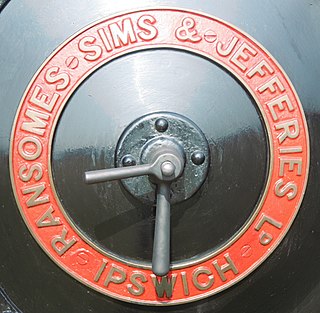
Ransomes, Sims and Jefferies Limited was a major British agricultural machinery maker also producing a wide range of general engineering products in Ipswich, Suffolk including traction engines, trolleybuses, ploughs, lawn mowers, combine harvesters and other tilling equipment. Ransomes also manufactured Direct Current electric motors in a wide range of sizes, and electric forklift trucks and tractors. They manufactured aeroplanes during the First World War. Their base, specially set up in 1845, was named Orwell Works.

Artificial leather, also called synthetic leather, is a material intended to substitute for leather in upholstery, clothing, footwear, and other uses where a leather-like finish is desired but the actual material is cost prohibitive or unsuitable. Artificial leather is known under many names, including leatherette, imitation leather, faux leather, vegan leather, PU leather, and pleather.
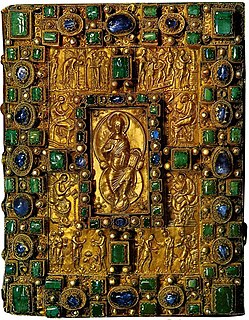
A treasure binding or jewelled bookbinding is a luxurious book cover using metalwork in gold or silver, jewels, or ivory, perhaps in addition to more usual bookbinding material for book-covers such as leather, velvet, or other cloth. The actual bookbinding technique is the same as for other medieval books, with the folios, normally of vellum, stitched together and bound to wooden cover boards. The metal furnishings of the treasure binding are then fixed, normally by tacks, onto these boards. Treasure bindings appear to have existed from at least Late Antiquity, though there are no surviving examples from so early, and Early Medieval examples are very rare. They were less used by the end of the Middle Ages, but a few continued to be produced in the West even up to the present day, and many more in areas where Eastern Orthodoxy predominated. The bindings were mainly used on grand illuminated manuscripts, especially gospel books designed for the altar and use in church services, rather than study in the library.
The F Stock was built in 1920 and 1921 for the District Railway by the Metropolitan Carriage, Wagon and Finance Co. They were partly funded by the government as part of an initiative to help British industry recover from World War I. One hundred steel-bodied cars were built: 40 driving motors, 12 control trailers and 48 trailers with the first train entering service on 23 December 1920. The cars were built with manually-operated sliding doors.

Bonded leather, also called reconstituted leather, composition leather or blended leather, is a term used for a manufactured upholstery material which contains animal hide. It is made as a layered structure of a fiber or paper backer covered with a layer of shredded leather fibers mixed with natural rubber or a polyurethane binder that is embossed with a leather-like texture.
The 1906 Stock, also known as "Gate Stock", was built for the Yerkes tube lines, Baker Street and Waterloo Railway (BS&WR), Great Northern, Piccadilly and Brompton Railway (GNP&BR), and Charing Cross, Euston and Hampstead Railway (CCE&HR).

A coach is a large closed four-wheeled passenger-carrying vehicle or carriage usually drawn by two or more horses usually controlled by a coachman, a postilion, or occasionally both. A coach has doors in its sides and a front and a back seat inside. The driver has a seat in front raised up high to give good vision. It is often called a box, box seat or coach box. The word coach came into use in the 15th century and spread across Europe. There are a number of types of coaches depending on how the vehicle is to be used. In India it is called a Rath or रथ. Special breeds of horses, such as the now-extinct Yorkshire Coach Horse, were developed to pull the heavy coaches.
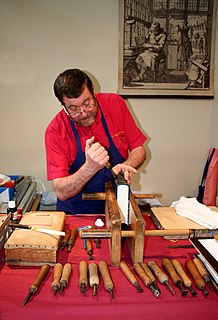
Bookbinding is the process of physically assembling a book of codex format from an ordered stack of paper sheets that are folded together into sections called signatures or sometimes left as a stack of individual sheets. Several signatures are then bound together along one edge with a thick needle and sturdy thread. Alternative methods of binding that are cheaper but less permanent include loose-leaf rings, individual screw posts or binding posts, twin loop spine coils, plastic spiral coils, and plastic spine combs. For protection, the bound stack is either wrapped in a flexible cover or attached to stiff boards. Finally, an attractive cover is adhered to the boards, including identifying information and decoration. Book artists or specialists in book decoration can also greatly enhance a book's content by creating book-like objects with artistic merit of exceptional quality.

Royal and viceroyal transport in Canada have included a variety of vehicles generally used for royal tours in Canada, and viceregal official and ceremonial duties in both the provincial and the federal spheres. The technology employed has mirrored the development of transportation since the late 17th century, when the first members of the Royal Family ventured from Great Britain to British North America. As the Canadian Royal Family is not predominantly resident in the country, those that belong to it have generally always had to make a trans-Atlantic crossing before switching to alternate over-land, water, or air transportation once in Canada.

The British Library contains a wide range of fine and historic bookbindings; however, books in the Library are organised primarily by subject rather than by binding so the Library has produced a guide to enable researchers to identity bindings of interest. The collection includes the oldest intact Western bookbinding, the leather binding of the 7th century St Cuthbert Gospel.

A steam railcar is a rail vehicle that does not require a locomotive as it contains its own steam engine. The first steam railcar was an experimental unit designed and built in 1847 by James Samuel and William Bridges Adams. In 1848 they made the Fairfield steam carriage that they sold to the Bristol & Exeter Railway, who used it for two years on a branch line.
Katharine Adams was a British bookbinder famous for her detailed leather bindings.
References
- ↑ "Glossary of Bookbinding Terms P-S". Redeye.co.nz. Retrieved 18 April 2019.
- ↑ "Glossary re antique teddy bears, vintage bears and collectable bears". Archived from the original on 2010-05-01. Retrieved 2010-05-22.
- ↑ George Orwell Diaries. W.W. Norton & Co. 2012. p. 377. ISBN 978-0-87140-410-7.
- ↑ Loft, Charles (2013). Last Trains; Dr Beeching and the Death of Rural England. sable publishers. p. 75. ISBN 9781849547123.
- ↑ "Railway Accidents" (PDF). Railwaysarchive.co.uk. Retrieved 18 April 2019.